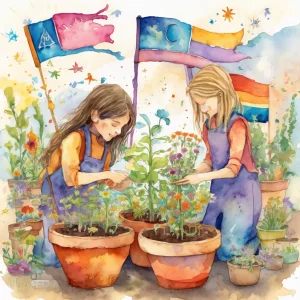Activity
Similar Activities
Empathy Tales: Digital Storytelling Journey
Children’s Age: 6–10 years
Activity Duration: 15 minutes
"Digital Storytelling with Empathy" is a creative activity for children aged 6 to 10, focusing on empathy, self-regulation, and language skills using digital tools. With a tablet o…
Activity Duration: 15 minutes
Enchanted Digital Storytelling Adventure through Nature's Wonders
Children’s Age: 5–18 years
Activity Duration: 50 minutes
Let's go on a "Digital Storytelling Adventure"! We'll create exciting stories using nature-themed digital images and fun drawing tools on a tablet or computer. Get ready to brainst…
Activity Duration: 50 minutes
Enchanted Tales: Move and Talk Story Time
Children’s Age: 3–4 years
Activity Duration: 5 minutes
"Move and Talk Story Time" is a delightful activity tailored for children aged 36 to 48 months, combining physical movement with language development. The goal is to boost flexibil…
Activity Duration: 5 minutes
Ecosystem Adventure Board Game - Nature's Quest
Children’s Age: 7–9 years
Activity Duration: 10 – 25 minutes
An interactive board game where children explore and learn about ecosystems through challenges and tasks.
Activity Duration: 10 – 25 minutes
Musical Freeze Painting: A Creative Dance Adventure
Children’s Age: 3 years
Activity Duration: 10 – 20 minutes
An engaging activity combining painting with musical freeze dance to promote creativity and play skills.
Activity Duration: 10 – 20 minutes
Space Collage Adventure: Crafting Cosmic Creativity Journey
Children’s Age: 3–8 years
Activity Duration: 10 – 20 minutes
Embark on a Space Collage Adventure where you can make cool space scenes using paper, scissors, and glue. Learn about space while creating your own unique collages with markers and…
Activity Duration: 10 – 20 minutes
Sensory Treasure Hunt: A Magical Exploration Journey
Children’s Age: 0 month – 6 years
Activity Duration: 10 minutes
Let's go on a Sensory Treasure Hunt! We will use our senses to explore different items like textures, scents, and sounds. You can feel, smell, and listen to each item while blindfo…
Activity Duration: 10 minutes
Whispers of the Blossoming Earth Journeys
Children’s Age: 11–15 years
Activity Duration: 50 – 55 minutes
Embark on the "Around the World Planting Adventure," a gardening activity designed for children aged 11 to 15. Through planting seeds from different countries, kids will learn abou…
Activity Duration: 50 – 55 minutes
Whispering Leaves: A Nature Dance Tale
Children’s Age: 6–10 years
Activity Duration: 20 – 30 minutes
Explore the "Nature Dance Story Circle" activity for children aged 6 to 10, focusing on communication, ecology, and values. Create a safe, spacious setting with a blanket and natur…
Activity Duration: 20 – 30 minutes
World Wonders: Around the World Dance Party
Children’s Age: 2–3 years
Activity Duration: 15 minutes
Introduce children aged 24 to 36 months to different cultures with the "Around the World Dance Party" activity. Set up a dancing space with world music and optional props like scar…
Activity Duration: 15 minutes
Holiday Sensory Bag Exploration – Festive Adventure
Children’s Age: 1–1.5 years
Activity Duration: 5 – 10 minutes
Introduce your 12 to 18-month-old to a Holiday Sensory Bag Exploration for sensory play and development. Prepare a bag with gel/oil, holiday items, and tape for a secure setup. Gui…
Activity Duration: 5 – 10 minutes
Enchanted Tea Party Adventure: A Magical Journey
Children’s Age: 3 years
Activity Duration: 10 – 15 minutes
Join us for a Magical Tea Party Adventure! Enhance your child's play skills, social-emotional growth, and language abilities through a whimsical tea party experience. Gather teacup…
Activity Duration: 10 – 15 minutes




























